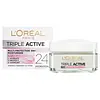What's inside
What's inside
 Key Ingredients
Key Ingredients

 Benefits
Benefits

 Concerns
Concerns

 Ingredients Side-by-side
Ingredients Side-by-side

Water
Skin ConditioningDibutyl Adipate
EmollientGlycerin
HumectantEthylhexyl Salicylate
UV AbsorberCetearyl Alcohol
EmollientEthylhexyl Triazone
UV AbsorberCoco-Caprylate
EmollientAlcohol
AntimicrobialButyl Methoxydibenzoylmethane
UV AbsorberBis-Ethylhexyloxyphenol Methoxyphenyl Triazine
Skin ConditioningPentaerythrityl Distearate
EmulsifyingGlyceryl Stearate
EmollientGlyceryl Stearate Citrate
EmollientPhenoxyethanol
PreservativeSodium Stearoyl Glutamate
CleansingPanthenol
Skin ConditioningCI 77891
Cosmetic ColorantTocopheryl Acetate
AntioxidantParfum
MaskingCaprylyl Glycol
EmollientHydroxyacetophenone
AntioxidantButyrospermum Parkii Butter
Skin ConditioningSclerotium Gum
Emulsion StabilisingAllantoin
Skin ConditioningGalactoarabinan
Helianthus Annuus Seed Cera
EmollientEthylhexylglycerin
Skin ConditioningDisodium EDTA
Xanthan Gum
EmulsifyingCitric Acid
BufferingSodium Hyaluronate
HumectantPanicum Miliaceum Seed Extract
Skin ConditioningUbiquinone
AntioxidantAlcohol Denat.
AntimicrobialCitronellol
PerfumingCaffeine
Skin ConditioningBenzyl Alcohol
PerfumingAlpha-Isomethyl Ionone
PerfumingTannic Acid
AstringentChlorella Vulgaris/Lupinus Albus Protein Ferment
Skin ConditioningColeus Forskohlii Root Extract
EmollientTocopherol
AntioxidantPotassium Sorbate
PreservativeSodium Benzoate
MaskingWater, Dibutyl Adipate, Glycerin, Ethylhexyl Salicylate, Cetearyl Alcohol, Ethylhexyl Triazone, Coco-Caprylate, Alcohol, Butyl Methoxydibenzoylmethane, Bis-Ethylhexyloxyphenol Methoxyphenyl Triazine, Pentaerythrityl Distearate, Glyceryl Stearate, Glyceryl Stearate Citrate, Phenoxyethanol, Sodium Stearoyl Glutamate, Panthenol, CI 77891, Tocopheryl Acetate, Parfum, Caprylyl Glycol, Hydroxyacetophenone, Butyrospermum Parkii Butter, Sclerotium Gum, Allantoin, Galactoarabinan, Helianthus Annuus Seed Cera, Ethylhexylglycerin, Disodium EDTA, Xanthan Gum, Citric Acid, Sodium Hyaluronate, Panicum Miliaceum Seed Extract, Ubiquinone, Alcohol Denat., Citronellol, Caffeine, Benzyl Alcohol, Alpha-Isomethyl Ionone, Tannic Acid, Chlorella Vulgaris/Lupinus Albus Protein Ferment, Coleus Forskohlii Root Extract, Tocopherol, Potassium Sorbate, Sodium Benzoate
Water
Skin ConditioningGlycerin
HumectantPentaerythrityl Tetraethylhexanoate
EmollientDimethicone
EmollientButylene Glycol
HumectantButyrospermum Parkii Butter
Skin ConditioningGlyceryl Stearate Se
EmulsifyingPEG-40 Stearate
EmulsifyingCetyl Alcohol
EmollientStearic Acid
CleansingPalmitic Acid
EmollientCamellia Oleifera Seed Oil
Skin ConditioningSorbitan Tristearate
EmulsifyingDimethiconol
EmollientSodium Hydroxide
BufferingPrunus Amygdalus Dulcis Oil
Skin ConditioningDisodium EDTA
Acrylates/C10-30 Alkyl Acrylate Crosspolymer
Emulsion StabilisingTocopherol
AntioxidantPentaerythrityl Tetra-Di-T-Butyl Hydroxyhydrocinnamate
AntioxidantPhenoxyethanol
PreservativeCI 14700
Cosmetic ColorantCI 19140
Cosmetic ColorantWater, Glycerin, Pentaerythrityl Tetraethylhexanoate, Dimethicone, Butylene Glycol, Butyrospermum Parkii Butter, Glyceryl Stearate Se, PEG-40 Stearate, Cetyl Alcohol, Stearic Acid, Palmitic Acid, Camellia Oleifera Seed Oil, Sorbitan Tristearate, Dimethiconol, Sodium Hydroxide, Prunus Amygdalus Dulcis Oil, Disodium EDTA, Acrylates/C10-30 Alkyl Acrylate Crosspolymer, Tocopherol, Pentaerythrityl Tetra-Di-T-Butyl Hydroxyhydrocinnamate, Phenoxyethanol, CI 14700, CI 19140
 Reviews
Reviews

Ingredients Explained
These ingredients are found in both products.
Ingredients higher up in an ingredient list are typically present in a larger amount.
This ingredient is also known as shea butter. It is an effective skin hydrator and emollient.
Emollients help soothe and soften your skin. It does this by creating a protective film on your skin. This barrier helps trap moisture and keeps your skin hydrated. Emollients may be effective at treating dry or itchy skin.
Shea butter is rich in antioxidants. Antioxidants help fight free-radicals, or molecules that may harm the body. It is also full of fatty acids including stearic acid and linoleic acid. These acids help replenish the skin and keep skin moisturized.
While Shea Butter has an SPF rating of about 3-4, it is not a sunscreen replacement.
Shea butter may not be fungal acne safe. We recommend speaking with a professional if you have any concerns.
Learn more about Butyrospermum Parkii ButterDisodium EDTA plays a role in making products more stable by aiding other preservatives.
It is a chelating agent, meaning it neutralizes metal ions that may be found in a product.
Disodium EDTA is a salt of edetic acid and is found to be safe in cosmetic ingredients.
Learn more about Disodium EDTAGlycerin is already naturally found in your skin. It helps moisturize and protect your skin.
A study from 2016 found glycerin to be more effective as a humectant than AHAs and hyaluronic acid.
As a humectant, it helps the skin stay hydrated by pulling moisture to your skin. The low molecular weight of glycerin allows it to pull moisture into the deeper layers of your skin.
Hydrated skin improves your skin barrier; Your skin barrier helps protect against irritants and bacteria.
Glycerin has also been found to have antimicrobial and antiviral properties. Due to these properties, glycerin is often used in wound and burn treatments.
In cosmetics, glycerin is usually derived from plants such as soybean or palm. However, it can also be sourced from animals, such as tallow or animal fat.
This ingredient is organic, colorless, odorless, and non-toxic.
Glycerin is the name for this ingredient in American English. British English uses Glycerol/Glycerine.
Learn more about GlycerinPhenoxyethanol is a preservative that has germicide, antimicrobial, and aromatic properties. Studies show that phenoxyethanol can prevent microbial growth. By itself, it has a scent that is similar to that of a rose.
It's often used in formulations along with Caprylyl Glycol to preserve the shelf life of products.
Tocopherol (also known as Vitamin E) is a common antioxidant used to help protect the skin from free-radicals and strengthen the skin barrier. It's also fat soluble - this means our skin is great at absorbing it.
Vitamin E also helps keep your natural skin lipids healthy. Your lipid skin barrier naturally consists of lipids, ceramides, and fatty acids. Vitamin E offers extra protection for your skin’s lipid barrier, keeping your skin healthy and nourished.
Another benefit is a bit of UV protection. Vitamin E helps reduce the damage caused by UVB rays. (It should not replace your sunscreen). Combining it with Vitamin C can decrease sunburned cells and hyperpigmentation after UV exposure.
You might have noticed Vitamin E + C often paired together. This is because it is great at stabilizing Vitamin C. Using the two together helps increase the effectiveness of both ingredients.
There are often claims that Vitamin E can reduce/prevent scarring, but these claims haven't been confirmed by scientific research.
Learn more about TocopherolWater. It's the most common cosmetic ingredient of all. You'll usually see it at the top of ingredient lists, meaning that it makes up the largest part of the product.
So why is it so popular? Water most often acts as a solvent - this means that it helps dissolve other ingredients into the formulation.
You'll also recognize water as that liquid we all need to stay alive. If you see this, drink a glass of water. Stay hydrated!
Learn more about Water